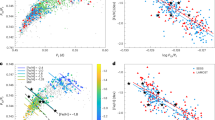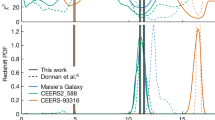Abstract
Mass is the most fundamental parameter of a star, yet it is also one of the most difficult to measure directly. In general, astronomers estimate stellar masses by determining the luminosity and using the ‘mass–luminosity’ relationship1,2, but this relationship has never been accurately calibrated for young, low-mass stars and brown dwarfs3. Masses for these low-mass objects are therefore constrained only by theoretical models1,2. A new high-contrast adaptive optics camera4,5,6 enabled the discovery of a young (50 million years) companion only 0.156 arcseconds (2.3 au) from the more luminous (> 120 times brighter) star AB Doradus A. Here we report a dynamical determination of the mass of the newly resolved low-mass companion AB Dor C, whose mass is 0.090 ± 0.005 solar masses. Given its measured 1–2-micrometre luminosity, we have found that the standard mass–luminosity relations1,2 overestimate the near-infrared luminosity of such objects by about a factor of ∼2.5 at young ages. The young, cool objects hitherto thought to be substellar in mass are therefore about twice as massive, which means that the frequency of brown dwarfs and planetary mass objects in young stellar clusters has been overestimated.
This is a preview of subscription content, access via your institution
Access options
Subscribe to this journal
Receive 51 print issues and online access
$199.00 per year
only $3.90 per issue
Buy this article
- Purchase on Springer Link
- Instant access to full article PDF
Prices may be subject to local taxes which are calculated during checkout




Similar content being viewed by others
References
Chabrier, G., Baraffe, I., Allard, F. & Hauschildt, P. Evolutionary models for very low-mass stars and brown dwarfs with dusty atmospheres. Astrophys. J. 542, 464–472 (2000)
Burrows, A., Hubbard, W. B., Lunine, J. I. & Liebert, J. The theory of brown dwarfs and extrasolar giant planets. Rev. Mod. Phys. 73, 719–765 (2001)
Bouy, H. et al. First determination of the dynamical mass of a binary L dwarf. Astron. Astrophys. 423, 341–352 (2004)
Close, L. M. et al. Extrasolar planetary science with adaptive optics. ESO workshop on adaptive optics. Astron. Soc. Pacif. (in the press)
Lenzen, R., Close, L. M., Brandner, W., Biller, B. & Hartung, M. A novel simultaneous differential imager for the direct imaging of giant planets. SPIE Symp. 5492,(in the press)
Biller, B. et al. An algorithm for the suppression of speckle-noise with the VLT & MMT SDI cameras. SPIE Symp. 5490,(in the press)
Perryman, M. A. C. et al. The HIPPARCOS catalogue. Astron. Astrophys. 323, L49–L52 (1997)
Zuckerman, B., Song, I. & Bessell, M. S. The AB Doradus moving group. Astrophys. J. 613, L65–L68 (2004)
Innis, J. L., Coates, D. W., Thompson, K. & Robinson, R. D. A study of the rapidly rotating variable star HD 36705 (AB Doradus). Astron. Soc. Aust. 6, 156–160 (1985)
Mewe, R., Kaastra, J. S., White, S. M. & Pallavicini, R. Simultaneous EUVE & ASCA observations of AB Doradus: temperature structure and abundances of the quiescent corona. Astron. Astrophys. 315, 170–178 (1996)
Vilhu, O., Gustafsson, B. & Walter, F. M. Spectroscopy of southern active stars. II. HD 32918, HD 82558, BD - 22 deg 3467, AB Doradus (HD 36705) and RST 137 B. Astron. Astrophys. 241, 167–175 (1991)
Randich, S., Pallavicini, R., Meola, G., Stauffer, J. R. & Balachandran, S. C. Membership, lithium, and metallicity in the young open clusters IC 2602 and IC 2391: Enlarging the sample. Astron. Astrophys. 372, 862–878 (2001)
Stelzer, B. & Neuhäuser, R. X-ray emission from young stars in the Tucanae association. Astron. Astrophys. 361, 581–593 (2000)
Barrado y Navascués, D., Deliyannis, C. P. & Stauffer, J. R. WIYN open cluster study. V. Lithium depletion and metallicity in G and K dwarfs of the open cluster M35. Astrophys. J. 549, 452–466 (2001)
Stauffer, J. R. et al. Why are the K dwarfs in the Pleiades so blue? Astron. J. 126, 833–847 (2003)
Martin, E. L. & Brandner, W. On the evolutionary status of two very active visual binaries. Astron. Astrophys. 294, 744–746 (1995)
Guirado, J. C. et al. Astrometric detection of a low-mass companion orbiting the star AB Doradus. Astrophys. J. 490, 835–846 (1997)
D'Antona, F. & Mazzitelli, I. Stellar models and luminosity functions for the Population II Main Sequence down to its lower end. Astrophys. J. 456, 329–349 (1996)
Hillenbrand, L. A. & White, R. J. An assessment of dynamical mass constraints on Pre-Main-Sequence evolutionary tracks. Astrophys. J. 604, 741–757 (2004)
Close, L. M., Siegler, N., Freed, M. & Biller, B. Detection of nine M8.0–L0.5 binaries: the very low mass binary population and its implications for brown dwarf and very low mass star formation. Astrophys. J. 587, 407–422 (2003)
Luhman, K. L. Young low-mass stars and brown dwarfs in IC 348. Astrophys. J. 525, 466–481 (1999)
Martín, E. L. et al. Membership and multiplicity among very low mass stars and brown dwarfs in the Pleiades cluster. Astrophys. J. 543, 299–312 (2000)
Ségransan, D. et al. Mass-luminosity relations of very low mass stars. Proc. IAU Symp. 211, 413–420 (2003)
Lucas, P. W. & Roche, P. F. A population of very young brown dwarfs and free-floating planets in Orion. Mon. Not. R. Astron. Soc. 314, 858–864 (2000)
Zapatero Osorio, M. R. et al. The substellar population in σ Orionis. Proc. IAU Symp. 211, 111–115 (2003)
Burgasser, A. J. et al. S Orionis 70: just a foreground field brown dwarf? Astrophys. J. 604, 827–831 (2004)
Marois, C. et al. TRIDENT: an infrared camera optimized for the detection of methanated substellar companions of nearby stars. High-contrast imaging for exo-planet detection. (ed. Schultz, A. B.) Proc. SPIE 4860, 130–137 (2003).
Lenzen, R. et al. NAOS-CONICA first on sky results in a variety of observing modes. Instrument design and performance for optical/infrared ground-based telescopes. (eds Iye, M. & Moorwood, A. F. M.) Proc. SPIE 4841, 944–952 (2003).
Wilking, B. A., Green, T. P. & Meyer, M. R. Spectroscopy of brown dwarf candidates in the ρ Oph molecular core. Astron. J. 117, 469–482 (1999)
Maiolino, R., Rieke, G. H. & Rieke, M. J. Correction of the atmospheric transmission in infrared spectroscopy. Astron. J. 111, 537–545 (1996)
Acknowledgements
We thank A. Kaufer, M. Kasper, J. Spyromilio, P. Gandhi and R. Gilmozzi for assistance with SDI commissioning. We thank O. Marco for support during the spectral observations. We thank D. McCarthy and M. Rademacher for help with the initial design of the NACO SDI optics. L.M.C. and B.B. acknowledge support from a NASA Origins grant. J.C.G. acknowledges support from a Spanish DGICYT grant. E.E.M. is supported by a Clay Fellowship from the Smithsonian Astrophysical Observatory. L.M.C. acknowledges support from an NSF Career award and SEC and EMC.
Author information
Authors and Affiliations
Corresponding author
Ethics declarations
Competing interests
The authors declare that they have no competing financial interests.
Rights and permissions
About this article
Cite this article
Close, L., Lenzen, R., Guirado, J. et al. A dynamical calibration of the mass–luminosity relation at very low stellar masses and young ages. Nature 433, 286–289 (2005). https://doi.org/10.1038/nature03225
Received:
Accepted:
Issue Date:
DOI: https://doi.org/10.1038/nature03225
This article is cited by
-
Weighing the baby
Nature (2005)
Comments
By submitting a comment you agree to abide by our Terms and Community Guidelines. If you find something abusive or that does not comply with our terms or guidelines please flag it as inappropriate.



